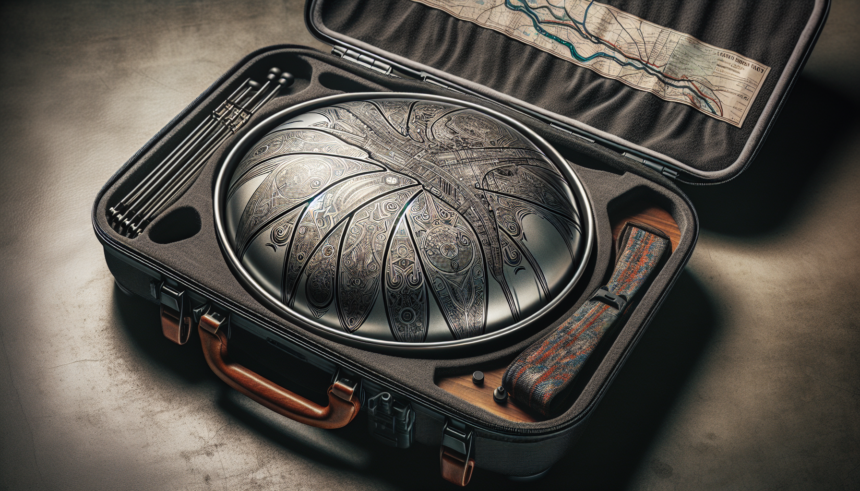Handpans, with their distinctive, resonant sound, have captivated musicians and audiences alike. Whether you are an experienced handpan player or a newcomer, taking your instrument on a road trip can open up new avenues for creativity and enjoyment. However, like all delicate musical instruments, handpans require specific care to ensure they remain in peak condition during long journeys. This article will guide you through everything you need to know to prepare your handpan for an extended trip, so you can focus on making beautiful music rather than worrying about your instrument’s safety.
Choosing the Right Handpan Case
The first step in preparing for a road trip with your handpan is choosing the right case. Handpan cases are crucial for protecting your instrument from physical damage, such as dents and scratches, as well as environmental factors like moisture and temperature fluctuations.
When selecting a case, there are a few factors to consider:
- Durability: Look for a case that offers robust protection. Hard cases made from materials like ABS plastic or fiberglass tend to offer the best protection against bumps and drops.
- Padding: Ensure your case has sufficient padding, especially around the edges and the dome. Soft, dense foam is ideal for cushioning your handpan and absorbing shocks.
- Water Resistance: Even if you don’t anticipate rain, it’s wise to select a case with some level of water resistance. This feature protects your instrument from unexpected weather or accidental spills.
- Portability: Given that you may need to carry your handpan for extended periods, choose a case that is comfortable to transport. Cases with padded straps and ergonomic designs are particularly useful.
Temperature and Humidity Control
Handpans are sensitive to changes in temperature and humidity. Extreme conditions can cause the metal to expand or contract, potentially affecting the tuning and overall integrity of your instrument. Here are some tips to protect your handpan:
- Use Silica Gel Packs: Placing silica gel packs inside your handpan case can help absorb excess moisture and prevent rust.
- Avoid Extreme Temperatures: Never leave your handpan in a car for prolonged periods, especially in hot or cold weather. If necessary, allow the instrument to acclimate gradually to temperature changes by letting it sit in its case before playing.
- Desiccant Bags: For added moisture control, consider using desiccant bags inside your case. These bags can help maintain a stable humidity level.
Packing and Loading Your Handpan
How you pack and load your handpan in your vehicle can greatly influence its safety during transport. Here’s how you can ensure your instrument is packed correctly:
- Secure Position: Place the handpan case in a secure position within your vehicle, ideally in a flat, stable spot. Avoid placing it in the trunk if other items can move and jostle the case.
- Away from Heavy Objects: Ensure no heavy objects can fall onto or press against your handpan case, as this can cause damage during quick stops or sudden turns.
- Cushion with Soft Items: If space allows, cushion your handpan case with soft items like blankets or pillows. This added layer helps to absorb any vibrations or minor impacts during the journey.
Regular Maintenance Checks
Even with the best preparations, regular maintenance checks are essential to ensure your handpan remains in top condition throughout your trip. Here’s a simple maintenance checklist:
- Visual Inspection: Regularly inspect the surface of your handpan for any signs of rust, dents, or scratches. Addressing small issues promptly can prevent larger problems later.
- Cleaning: Clean your handpan with a soft cloth to remove dust and fingerprints. If required, use a specialized cleaner recommended by the manufacturer.
- Tuning Check: Regularly check the tuning of your handpan. If you notice any changes in pitch or resonance, consult a professional tuner to address the issue.
Playing Etiquette on the Road
Playing your handpan in new environments can be incredibly rewarding, but it’s important to be mindful of where and when you play. Here are some guidelines for respectful handpan playing on the road:
- Noise Levels: Be conscious of your surroundings and consider the noise levels in your chosen location. Public spaces such as parks and beaches are often more suitable for playing than residential areas.
- Permission: In some locations, playing musical instruments may require permission from local authorities or property owners. Always check ahead to avoid any legal issues.
- Respecting Nature: If you choose to play in natural settings like forests or by the water, be sure to respect the environment. Avoid disturbing wildlife and leave no trace of your visit.
Insurance and Documentation
Insurance and proper documentation are often overlooked but crucial aspects of traveling with a valuable instrument like a handpan. Here’s what you should consider:
- Instrument Insurance: Look into specialized musical instrument insurance to protect your handpan against theft, loss, or damage. This can provide peace of mind and financial protection.
- Documentation: Keep a documented inventory of your instrument, including serial numbers, photos, and receipts. This information is invaluable in case of loss or damage, assisting in recovery or insurance claims.
- Travel Papers: If you’re traveling internationally, ensure you have the necessary documentation for your handpan. Some countries have strict regulations on musical instruments, especially those made from specific materials.
Emergency Kit for Your Handpan
Having an emergency kit specifically for your handpan can be a lifesaver in unforeseen situations. Here’s what to include:
- Extra Cleaning Supplies: Carry a small kit with a soft cloth, specialized cleaner, and silica gel packs to address any immediate maintenance needs.
- Repair Tools: While major repairs should be left to professionals, having basic tools like a tuning hammer and small clamps can help with minor fixes.
- Spare Case or Cover: In case your primary case is damaged, having a backup cover or a soft bag can provide temporary protection.
Conclusion
Embarking on a road trip with your handpan can be an exhilarating experience, allowing you to share your music with new audiences and draw inspiration from diverse surroundings. By taking the necessary preparations—from choosing the right case and managing environmental factors to performing regular maintenance and respecting local etiquette—you can ensure your handpan remains in perfect condition. This foresight not only protects your valuable instrument but also allows you to focus on the joy of playing and the unique experiences awaiting you on your journey.
Remember that while handpans are sturdy instruments, they require dedicated care and attention, especially during long hauls. With thoughtful preparation, your handpan will continue to resonate beautifully, no matter where the road takes you.
FAQs
1. Can I carry my handpan as cabin luggage on a flight?
Policies vary between airlines, but many allow handpans as carry-on luggage if they fit within size restrictions. Always check with your airline beforehand to ensure compliance with their guidelines and to avoid surprises at the airport.
2. How can I protect my handpan from rust during a long trip?
Using silica gel packs and desiccant bags inside your case can help manage moisture and prevent rust. Regularly cleaning your handpan and applying a rust-preventive product recommended by the manufacturer can also be beneficial.
3. What type of handpan case is best for road trips?
A hard case with robust padding is ideal for road trips. Cases made from ABS plastic or fiberglass provide excellent protection against physical damage. Additionally, opt for cases with water resistance and comfortable straps for ease of transport.
4. Is it necessary to get insurance for my handpan?
While not mandatory, insuring your handpan offers valuable protection against theft, loss, or damage during your travels. Specialized musical instrument insurance is recommended to provide financial security and peace of mind.
5. How often should I check the tuning of my handpan on a long trip?
Regularly checking the tuning of your handpan is essential, especially after long stretches in varying climates. Perform tuning checks every few days or whenever you notice a change in pitch or resonance to ensure your instrument sounds its best.





